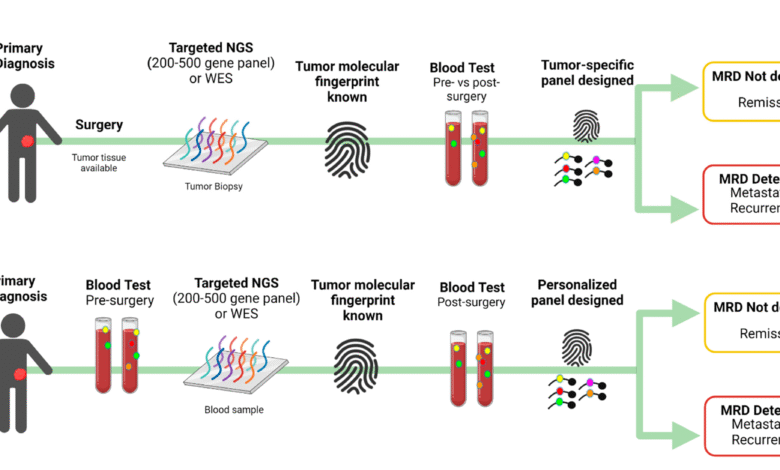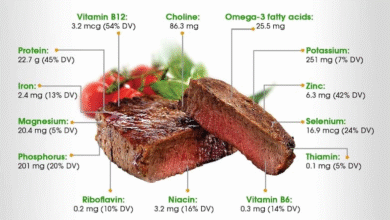ctDNA Tests: New Hope for Skin Cancer Detection

Circulating tumor DNA (ctDNA) tests are emerging as a groundbreaking tool in the fight against skin cancer, particularly melanoma, by enabling earlier detection and monitoring of recurrence. Research from NYU Langone Health reveals that these blood tests can reveal vital insights about cancer activity before symptoms manifest, significantly improving early cancer diagnosis. With approximately 80% of stage 3 melanoma patients showing detectable ctDNA levels indicating a high likelihood of recurrence, ctDNA tests could transform how we approach skin cancer detection. This innovation not only offers a more accessible method of tracking cancer but also stands to enhance the effectiveness of treatment strategies. As the medical community embraces the potential of blood tests for cancer, ctDNA analysis represents a promising frontier, bridging the gap between hope and effective intervention for those battling this aggressive disease.
Liquid biopsies, particularly those analyzing circulating tumor DNA (ctDNA), are revolutionizing the approach to skin cancer, emphasizing the significance of timely intervention in conditions like melanoma. This innovative method allows for the identification of malignant growths through comprehensive blood tests, leading to earlier skin cancer detection and a better understanding of when melanoma might recur. By focusing on the genetic material shed by tumors, these tests open new avenues for proactive cancer management, enhancing the prospects of patients facing this challenging diagnosis. As the research progresses, the potential applications of ctDNA tests extend beyond melanoma, reinforcing their role in the broader context of cancer care and early disease identification. The ongoing exploration and validation of these liquid biopsy techniques illustrate a commitment to improving patient outcomes across various cancer types.
The Role of ctDNA Tests in Early Cancer Diagnosis
Circulating tumor DNA (ctDNA) tests are revolutionizing the realm of early cancer diagnosis, particularly for aggressive forms like melanoma. These blood tests analyze fragments of DNA shed by tumors into the bloodstream, offering a non-invasive approach to monitoring cancer progression. This methodology enables healthcare professionals to detect the presence of cancerous cells earlier than conventional imaging methods, significantly improving the chances of successful intervention before symptoms manifest.
The importance of early detection cannot be overstated, especially for skin cancer detection. Melanoma, known for its rapid progression if left untreated, can become more manageable with timely intervention. By leveraging ctDNA tests, oncologists gain critical insights into a patient’s disease state, enabling them to initiate treatment strategies sooner and enhance overall survival rates.
Understanding Melanoma Recurrence Through Blood Tests
Melanoma recurrence is a pressing concern for patients and healthcare providers alike, necessitating effective monitoring strategies. The recent study from NYU’s Perlmutter Cancer Center underscores how blood tests for cancer, particularly those assessing ctDNA levels, can serve as reliable indicators of recurrence. With nearly 80% of stage 3 melanoma patients exhibiting detectable ctDNA, this method reveals an alarming propensity for the cancer to return post-treatment, making regular monitoring essential.
This research highlights that traditional monitoring techniques may fall short, especially when melanoma has progressed to the lymph nodes. Blood tests for cancer, specifically targeting circulating tumor DNA, present a viable alternative, enhancing the accuracy of recurrence predictions. As these blood tests become more widely adopted, they will provide physicians with a sharper tool to recognize recurrence early and tailor treatment plans that could ultimately lead to better outcomes.
Advancements in Blood Tests for Cancer Monitoring
The advancements in blood tests for cancer monitoring mark a crucial step forward in oncological care. With the introduction of ctDNA testing, researchers have uncovered a potent method for identifying the recurrence of skin cancer and other malignancies. These tests are transforming the landscape of cancer care by offering a more dynamic approach to monitoring treatment effectiveness and disease progression, especially for cancers that are notoriously difficult to detect early.
Blood tests for cancer now serve not only as a diagnostic tool but also as a means of tailoring individualized therapy. By focusing on circulating tumor DNA, clinicians can better assess how patients respond to treatment and make informed decisions about future interventions. This personalized methodology fosters a more proactive stance in cancer management, underscoring the growing importance of integrating innovative blood testing techniques into standard clinical practice.
Contemporary Challenges in ctDNA Testing
While ctDNA testing represents a significant leap forward in cancer detection and monitoring, challenges remain. For instance, cases where patients test negative for ctDNA yet still experience recurrence highlight the complexities surrounding cancer biology. These discrepancies complicate the interpretation of results and necessitate further research to refine testing protocols, ensuring higher sensitivity and specificity in detecting malignant activity.
Additionally, the landscape of melanoma and other forms of cancer is ever-evolving, requiring ongoing adaptation of ctDNA testing methods. Established clinical guidelines are essential for interpreting ctDNA test results to avoid false confidence in negative outcomes. As researchers continue to evaluate these challenges, the goal remains clear: to enhance the reliability of ctDNA tests and empower clinicians with robust data that aids in the fight against cancer.
The Future of Circulating Tumor DNA Research
The future of circulating tumor DNA research is promising, particularly in the context of early cancer diagnosis and monitoring treatment responses. As studies continue to validate the effectiveness of ctDNA testing, expect to see breakthroughs that enhance our understanding of cancer recurrence, particularly in challenging cases like melanoma. The potential applications of ctDNA are expansive, ranging from tailored treatment plans to innovative therapies designed specifically for a patient’s unique tumor profile.
Moreover, the integration of ctDNA testing into routine clinical practice could shift the paradigm towards more personalized cancer care. As we gather more data on its efficacy, the hope is that ctDNA tests will not only become a standard practice in monitoring melanoma but will also extend to various other cancers. This evolution could fundamentally change how oncologists approach patient management and improve survival outcomes across the board.
Educating Patients About Blood Tests for Cancer
An essential aspect of enhancing cancer care involves educating patients about the role of blood tests for cancer, particularly ctDNA tests. Understanding how these tests work and their implications in monitoring cancer can empower patients to take a proactive role in their health management. By fostering awareness about early detection and the importance of regular monitoring, healthcare professionals can facilitate better patient outcomes.
Moreover, educating patients on what to expect from ctDNA testing—including the potential for false negatives and the importance of follow-up—is crucial in setting realistic expectations. It is imperative that patients feel informed and supported throughout their treatment journey, as this knowledge can significantly impact their engagement and compliance with recommended surveillance protocols.
The Integration of LSI in Cancer Research
Latent Semantic Indexing (LSI) plays a pivotal role in enhancing the relevance of cancer research and optimizing content around emerging trends such as ctDNA testing. By incorporating related terms and concepts, researchers can better set the stage for discussions about blood tests for cancer, early cancer diagnosis, and the implications of circulating tumor DNA on patient care. This approach not only bridges gaps in knowledge but also promotes deeper insights into the complexities of cancer detection.
Utilizing LSI within cancer research helps both scientists and medical professionals discover connections between various aspects of oncology. For instance, incorporating terms related to skin cancer detection and melanoma recurrence can yield richer discussions that drive innovation in treatment approaches and diagnostic strategies. As research expands in scope, leveraging LSI will play an invaluable role in advancing the field of cancer care and improving patient outcomes.
Clinical Trials and ctDNA Testing
Clinical trials have become the cornerstone for validating the efficacy and safety of ctDNA testing in oncology. These trials are essential for establishing the relationship between circulating tumor DNA levels and the likelihood of skin cancer recurrence, thus laying the groundwork for future clinical applications. By closely examining patient responses in controlled settings, researchers can refine ctDNA testing technologies to ensure they provide accurate, reliable information in monitoring cancer progression.
Through rigorous clinical trials, the oncological community can gain invaluable insights into how ctDNA tests perform compared to traditional diagnostic methods. With the promise of earlier cancer diagnosis and better monitoring capabilities, successful trials could lead to the widespread adoption of ctDNA testing in clinical practice, setting a new standard for patient surveillance and management in melanoma and beyond.
Impact of Technology on Cancer Detection
The rapid advancement of technology has fundamentally transformed the landscape of cancer detection and treatment. Innovations in blood tests for cancer, particularly the development of ctDNA testing, have ushered in a new era of early cancer diagnosis. With these technological strides, healthcare providers can leverage sophisticated tools to analyze genetic material found in a patient’s bloodstream, enhancing their ability to detect potential malignancies at their earliest stages.
Moreover, the integration of technology extends beyond testing itself; it encompasses data analysis and real-time monitoring of patient health. The ability to track circulating tumor DNA levels dynamically enables a more comprehensive understanding of disease evolution and recurrence patterns, making it a powerful ally in personalized cancer care. As technology continues to advance, the potential implications for patient outcomes could be profound, turning ctDNA testing into a mainstay of modern oncology.
Patient Stories: Real-World Impact of ctDNA Testing
The real-world impact of ctDNA testing is best illustrated through patient stories that highlight its transformative potential. Many individuals who have undergone ctDNA testing report a sense of empowerment knowing that they are actively participating in their cancer journey. By monitoring circulating tumor DNA levels, these patients can gain insights into their health status, fostering a collaborative relationship with their healthcare team that focuses on proactive care.
These patient narratives often emphasize the hope that ctDNA testing instills. For those navigating melanoma and other aggressive cancers, having access to real-time data on tumor recurrence can significantly alleviate the anxiety surrounding unpredictable disease progression. As more patient experiences are shared, the role of ctDNA testing becomes clear, illustrating its importance not only in clinical decision-making but also in enhancing the quality of life for individuals affected by cancer.
Frequently Asked Questions
What is ctDNA testing and how is it related to skin cancer detection?
Circulating tumor DNA (ctDNA) testing involves analyzing blood samples to detect fragments of DNA shed by tumors into the bloodstream. This test is crucial for skin cancer detection, especially melanoma, as it can reveal the presence of cancerous cells before symptoms manifest. It offers a non-invasive method to monitor the disease and helps in early cancer diagnosis.
How effective are ctDNA tests in predicting melanoma recurrence?
Research shows that ctDNA tests are highly effective in predicting melanoma recurrence. About 80% of stage 3 melanoma patients with detectable ctDNA levels experienced a return of cancer. This makes ctDNA analysis a vital tool for monitoring patients post-treatment and ensuring timely interventions.
Can ctDNA tests identify early cancer diagnosis for skin cancer patients?
Yes, ctDNA tests are pivotal for early cancer diagnosis in skin cancer patients. They enable healthcare providers to identify cancer recurrence sooner than traditional imaging methods, thus improving the chances of successful treatment before cancer advances.
Why are blood tests for cancer, like ctDNA tests, gaining popularity in melanoma treatment?
Blood tests for cancer, particularly ctDNA tests, are increasing in popularity due to their ability to provide real-time insights into cancer status. They surpass traditional monitoring techniques by offering a direct measurement of cancer presence, making them essential for effective melanoma management.
What challenges remain in refining ctDNA tests for melanoma?
Despite their promise, challenges remain in refining ctDNA tests for melanoma. Instances of cancer recurrence have been noted even when ctDNA tests yield negative results. Researchers aim to enhance these tests’ accuracy to minimize false negatives and improve cancer monitoring.
How does ctDNA analysis compare to traditional tumor testing for melanoma patients?
CtDNA analysis is often more effective than traditional tumor testing methods for melanoma patients. This blood-based approach not only predicts recurrence with greater accuracy but also provides continuous monitoring of the disease, allowing for more informed treatment decisions.
What role does ctDNA testing play in the treatment decisions for melanoma patients?
CtDNA testing plays a significant role in shaping treatment decisions for melanoma patients. By identifying the presence of circulating tumor DNA in the bloodstream, doctors can adjust treatment plans proactively, enhancing the likelihood of effective patient outcomes and potentially extending survival rates.
How do researchers gather data for ctDNA tests in melanoma studies?
Researchers gather data for ctDNA tests in melanoma studies by analyzing blood samples from cancer patients and assessing levels of circulating tumor DNA in comparison to cancer recurrence evidence. This approach provides valuable insights into the correlation between ctDNA presence and melanoma progression.
| Key Point | Details |
|---|---|
| Blood Tests for Cancer Recurrence | Blood tests can signal the return of cancer, specifically skin cancer, before symptoms appear. |
| Research Institution | NYU Langone Health and Perlmutter Cancer Center conducted the research. |
| Focus on Melanoma | Study concentrated on stage 3 melanoma patients, which is a more dangerous form of skin cancer. |
| Circulating Tumor DNA (ctDNA) | ctDNA levels in blood can predict cancer recurrence effectively. |
| Study Findings | 80% of stage 3 melanoma patients with detectable ctDNA experienced cancer recurrence. |
| Comparison with Traditional Methods | ctDNA tests are as effective, if not better, than traditional tumor analysis methods. |
| Challenges | Some patients experienced recurrence without detectable ctDNA before therapy. |
| Future Improvements | Researchers are refining ctDNA tests to improve accuracy and reduce false negatives. |
Summary
ctDNA tests represent a groundbreaking advancement in cancer diagnostics, providing a crucial tool for early detection of cancer recurrence. As demonstrated in recent studies, these blood tests offer a reliable method to monitor melanoma, potentially saving lives by identifying resurgence before symptoms manifest. The ongoing refinement of ctDNA analyses promises to enhance their predictive accuracy, ensuring that patients receive timely interventions to combat this aggressive disease.




